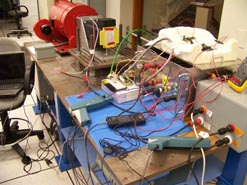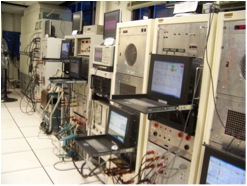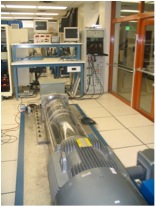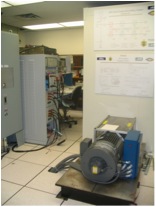Energy Conversion Research Laboratory
Purdue's Energy Conversion Research Laboratory (ECRL) was established in August 1999 and represents an approximately $2 million investment by Purdue, the National Science Foundation, the Office of Naval Research, and the Naval Sea Systems Command. The laboratory supports research in electric machinery, drives, power electronics, and power systems.
The facility is used for studies on the modeling and control of rotating electric machinery and power electronics based power conversion systems. A typical experiment in the laboratory may include the demonstration of a new silicon-carbide based semiconductor drive, the development of a new control to minimize induction motor loss, the testing of a new type of electric motor, or trials of a new control strategy to minimize acoustic noise production in a trapezoidal back emf permanent magnet motor drive.
This laboratory consists of nine research stations at a power levels from 100W - 110 kW. The laboratory houses three 28 Nm, 20,000 rpm one-quadrant dynamometers, a 19 kW, 5900 rpm four-quadrant dynamometer, a 37 kW, 3900 rpm four-quadrant dynamometer with sound room, and finally a 112 kW, 3600 rpm four quadrant dynamometer. Supporting equipment includes numerous Tektronix and LeCrox digital oscilloscopes, differential high-voltage probes, hall-effect current probes, and numerous Sorenson 0-400 V and 0-600 V DC power supplies. In addition, the facility includes test equipment including a HP4284A precision LCR meter for stand-still frequency response testing, and an Agilent 16 channel data acquisition system. Lab control and data acquisition are based on National Instruments LabView. Three phase 230 V l-l rms and 480 V l-l rms utility voltages are also available.
A unique feature of the facility is that all stations can be interconnected through dual 3-phase distribution systems running throughout the lab. This is often used to create scaled power systems within the lab to test advanced system control concepts. The demonstration of Naval shipboard power systems architectures has been a recurring theme in this regard.
 |
 |
| 19kW 4-Quadrant Dynamometer | Power Electronics Based Power System |
 |
 |
| 112kW 4-Quadrant Dynamometer | 37kW 4-Quadrant Dynamometer |
